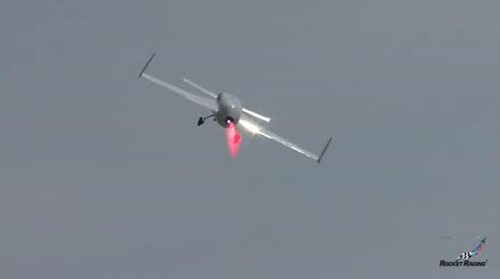Rocket Racing League’s Engine Switch Leaves Questions

Agrowing fleet of rocket-powered racers will fly with a liquid oxygen andalcohol engine developed by Armadillo Aerospace, instead of an XCOR Aerospacedesign used during the Rocket Racing League's public debut earlier this summer.
Theleague had originally planned to pit a racer with an XCOR engine against aracer with an Armadillo engine in the upcoming Reno Air Races set for Sept.10-14 in Reno, Nev., but for now will only use the Armadillo engine, saidleague officials.
"Whenwe feel the XCOR engines meet our standards of safety, reliability,reusability, and performance for a rocket racer, then we may bring them backinto the league," RocketRacing League co-founder and CEO Granger Whitelaw told SPACE.com lastweek.
TheRocket Racing League formed in 2005 to promote NASCAR-styleracing in the sky. The league currently has six teams on its roster undertitle sponsor DKNY Men, a New York City-based men's sportswear line that isalso backing the Bridenstine Rocket Racing Team headed by former U.S. Navy jetpilot Jim Bridenstine.
Arocket racer equipped with the Armadillo engine recently completed seven testflights at the Oklahoma Spaceport in Burns Flat, Okla.
Nodetails emerged about exactly why the league decided to hold off on using theXCOR engine, but the decision leaves open the question of what, if anything,will fly at Reno. As of Sept. 5, the Federal Aviation Administration still hadnot granted approval for a public demonstration of a racer powered by the Armadilloengine.
Thedecision also comes despite the league's smoothdebut with an XCOR engine-powered racer in late July and early August atthe EAA AirVenture air show in Oshkosh, Wisc. Whitelaw called the Oshkosh event"a very controlled flight test," and added that XCOR Aerospace isstill running flight and engineering tests.
Breaking space news, the latest updates on rocket launches, skywatching events and more!
Meanwhile,the XCOR Aerospace firm based out of Mojave, Calif. continued to expressconfidence in its engine.
"Westill have a few last things to test, but so far the engine is very solid andwe're very proud of the performance of the engine," said Douglas Graham,an XCOR spokesperson. He added that that XCOR holds no hard feelings againstthe Mesquite, Texas-based Armadillo Aerospace firm.
"Wehave nothing but praise for them," Graham told SPACE.com."Both of our engines have different performance characteristics anddifferent qualities and different levels of complexity."
Aside-by-side comparison of the engines shows some of the differences. The XCORengine emerged from a program aimed at developing suborbital flight, while theArmadillo engine grew out of a more vertical approach to the Northrop GrummanLunar Lander Challenge. The liquid oxygen and kerosene engine developed by XCORmaintains steady thrust throughout its burn, unlike Armadillo's liquid oxygenand alcohol engine where thrust drops off as fuel burns off.
Grahamemphasized that XCOR Aerospace has a history of safe and reliable development,in answer to any uncertainty that might arise from the league's recentannouncement.
"XCORhas performed more than 50 manned rocket flights with no loss or damage to thevehicle," Graham said. "We've fired engines more than 3,500 times inour nine-year history without any time loss for injury because of the operationof a rocket engine. That's a safety record that speaks for itself."
Whitelaw,a racing car veteran of the Indianapolis 500, did not elaborate on anyrequirements that XCOR's engine might need to meet. But he praised ArmadilloAerospace and its founder, John Carmack, for rapidly responding to the league'sspecifications throughout a six-month test period.
"Johnwill literally solve the problem, design the part and implement the change inhours," Whitelaw said. "And that's what you have to be able to dowith racing."
Theleague plans to officially start its season with 10 rocket racers, six of whichwill carry Armadillo engines. The other four racer engines "will be up forgrabs," according to Whitelaw.
Rocketracing events may include the Reno National Championship Air Races in Reno,Nev., between Sept.10-14 and Aviation Nation at Nellis Air Force Base in LasVegas, Nev., on Nov. 8-9.
Thisstory was updated at 11:58 p.m. EDT on Sept. 10.
- Video - Rocket Racing League Inaugural Flight
- Video - Rocket Racing Visionaries
- Future of Flight: Space Tourism, Investment and Technology
Jeremy Hsu is science writer based in New York City whose work has appeared in Scientific American, Discovery Magazine, Backchannel, Wired.com and IEEE Spectrum, among others. He joined the Space.com and Live Science teams in 2010 as a Senior Writer and is currently the Editor-in-Chief of Indicate Media. Jeremy studied history and sociology of science at the University of Pennsylvania, and earned a master's degree in journalism from the NYU Science, Health and Environmental Reporting Program. You can find Jeremy's latest project on Twitter.
